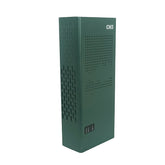This is how drones can be taken from the sky
Berlin London airports are modernizing: Heathrow and Gatwick are investing millions in drone defense technology after Gatwick's flight operations were massively affected by drones shortly before Christmas.
To rule out similar incidents in the future, airport managers rely on a technology also used by the British armed forces: jammers prevent communication between the drone and its pilot on the ground and thus force the flying object to ask.
The operators left open the system actually used at London airports. A candidate would be the defense system of the Israeli manufacturer Rafael, which has proven itself, among other things, in the deployment of British and American forces in Syria and Iraq. Its high-tech radar detects approaching drones from a distance of several kilometers.
If the flying object is classified as a threat, the interference signals overload the drone's communication system. The connection to the drone navigator is interrupted, the flying object crashes or must make an emergency landing. If desired, the defense weapon can also be equipped with a laser system for direct drone fire.
The aeronautical group Airbus has also developed a system to keep drones away from restricted airspace. Not only does it disrupt the drone's electronics, but it can also locate its pilot. The example of Gatwick shows how problematic finding the cause of a drone incident can be, where police are always on the lookout for the senders of the mini-plane.

Other defense systems attack the GPS navigation of drones. With special jammers, called GPS jammer, the connection of the flying object to the satellites of the global positioning system can be cut off. The so-called GPS spoofing is more complex, in which the drone is claimed to have a bad GPS signal which is supposed to distract it from the course.
Laser cannon and safety net
Systems that fire directly at drones are less suitable for protecting civilian installations. Laser cannons such as the Compact Laser Weapons System developed by the American airline Boeing are more suitable for military use. The Laser Weapon System, first installed on a US warship in 2014, also relies on laser technology: the high-energy light beam can still destroy drones from around 15 kilometers away.
The Skywall system from the British company Openworks Engineering looks like a cross between an air rifle and a bazooka. The shoulder-supported defense system triggers a safety net that wraps around an approaching drone and crashes it. However, the range of the air pressure-fired array projectile is rather short.
Drone-based drone hunting looks more promising: For example, researchers at Michigan Technological University have developed a hunting drone that shoots a net into the air in which an unwanted intruder gets caught. In order to avoid an uncontrolled fall, the captured object remains connected to the receiver by a line and can be used to bring it out of the danger zone.
A defense system that has been tested in the Netherlands, among other places, works entirely without technology: there, specially trained birds of prey fall on drones and cause them to crash
In airports, the use of animals would even have a useful side: their appearance keeps the dreaded flocks of birds away from pilots. At airports where falconers specifically let birds of prey fly, the number of feathered animals forming swarms has dropped by 90%.













